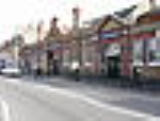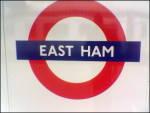
East Ham tube station
Encyclopedia
East Ham tube station is a London Underground
station on the District
and Hammersmith and City
lines, located in East Ham
, east London
. It is in both Zone 3
and Zone 4
. The station exit is on High Street North.
 The station was opened by the London, Tilbury and Southend Railway
The station was opened by the London, Tilbury and Southend Railway
(LT&SR) in 1858. District Line service began in 1902. The District Line was electrified in 1905 and the service was cut back from Upminster to East Ham; the station then served as the eastern terminus, where passengers transferred to steam trains, until 1908 when electrification was extended to Barking. In 1936 the Metropolitan Line
service was introduced. In 1988 the station, along with other stations beyond Aldgate East, was transferred to the new Hammersmith & City line.
The station has two platforms, one for each direction. A third bay platform
on the northern side of the station, closed in 1958, connected to the Tottenham and Forest Gate Railway
(now the Gospel Oak to Barking line
) via a curve. LT&SR services, withdrawn in 1962, used platforms to the south of the current station. Much of the original Victorian station architecture has been retained and some restoration work was carried out during 2005.
}
London Underground
The London Underground is a rapid transit system serving a large part of Greater London and some parts of Buckinghamshire, Hertfordshire and Essex in England...
station on the District
District Line
The District line is a line of the London Underground, coloured green on the Tube map. It is a "sub-surface" line, running through the central area in shallow cut-and-cover tunnels. It is the busiest of the sub-surface lines. Out of the 60 stations served, 25 are underground...
and Hammersmith and City
Hammersmith & City Line
The Hammersmith & City line is a subsurface London Underground line. It connects Hammersmith in the west with Barking in the east, running through the northern part of central London. It is coloured salmon pink on the Tube map...
lines, located in East Ham
East Ham
East Ham is a suburban district of London, England, and part of the London Borough of Newham. It is a built-up district located 8 miles east-northeast of Charing Cross...
, east London
London
London is the capital city of :England and the :United Kingdom, the largest metropolitan area in the United Kingdom, and the largest urban zone in the European Union by most measures. Located on the River Thames, London has been a major settlement for two millennia, its history going back to its...
. It is in both Zone 3
Travelcard Zone 3
Fare zone 3 is a zone of Transport for London's zonal fare system used for calculating the price of tickets for travel on the London Underground, London Overground, Docklands Light Railway and, since 2007, on National Rail services...
and Zone 4
Travelcard Zone 4
Fare zone 4 is a zone of Transport for London's zonal fare system used for calculating the price of tickets for travel on the London Underground, London Overground, Docklands Light Railway and, since 2007, on National Rail services...
. The station exit is on High Street North.

London, Tilbury and Southend Railway
The London, Tilbury and Southend Railway is an English railway line linking Fenchurch Street railway station in the City of London with northeast London and the entire length of the northern Thames Gateway area of southern Essex. It is currently known as the Essex Thameside Route by Network Rail...
(LT&SR) in 1858. District Line service began in 1902. The District Line was electrified in 1905 and the service was cut back from Upminster to East Ham; the station then served as the eastern terminus, where passengers transferred to steam trains, until 1908 when electrification was extended to Barking. In 1936 the Metropolitan Line
Metropolitan Line
The Metropolitan line is part of the London Underground. It is coloured in Transport for London's Corporate Magenta on the Tube map and in other branding. It was the first underground railway in the world, opening as the Metropolitan Railway on 10 January 1863...
service was introduced. In 1988 the station, along with other stations beyond Aldgate East, was transferred to the new Hammersmith & City line.
The station has two platforms, one for each direction. A third bay platform
Bay platform
Bay platform is a railway-related term commonly used in the UK and Australia to describe a dead-end platform at a railway station that has through lines...
on the northern side of the station, closed in 1958, connected to the Tottenham and Forest Gate Railway
Tottenham and Forest Gate Railway
The Tottenham & Forest Gate Railway was a railway line in north London, formed by an Act of Parliament of 1890 and built as joint venture between the Midland Railway and the London, Tilbury and Southend Railway...
(now the Gospel Oak to Barking line
Gospel Oak to Barking line
The Gospel Oak – Barking Line is a railway line in north and east London which connects Gospel Oak in North London and Barking in East London as part of the London Overground network. It is sometimes known as the Goblin , although this is a nickname rather than an official title...
) via a curve. LT&SR services, withdrawn in 1962, used platforms to the south of the current station. Much of the original Victorian station architecture has been retained and some restoration work was carried out during 2005.
Transport links
London bus routes 101, 104, 147, 238, 300, 325, 376 and 474 (24hours).External links
}

